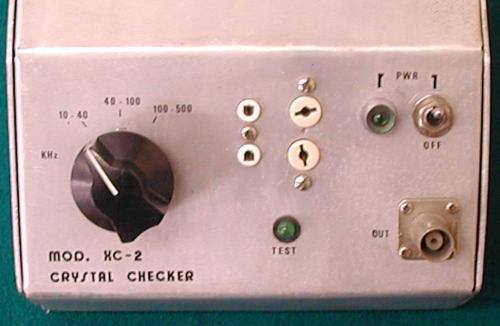Low-Frequency Crystal Controlled Oscillator
Description:
The RF engineer sometimes has to look for an instrument that will check a low frequency
quartz crystal unit reliably and rapidly. This is a difficult piece of equipment
to find and the engineer often has to consult an electronic circuits handbook for
the schematic of a circuit that will perform the task.
Unfortunately, there aren't many such circuits in the technical literature currently
available, and when found, they don't always work as expected. A circuit that has
been found to work at full satisfaction in the frequency range from 10 kHz to 500
kHz is illustrated in Figure 1.

Low-Frequency Crystal Controlled
Oscillator circuit
This is a schematic of a low frequency sine wave oscillator featuring low distortion,
wideband operation and crystal control.The circuit, originally developed for laboratory
use, employs low cost AF bipolar transistors for the oscillator and amplifier sections
and a JFET for loop-gain control. Operation of the oscillator in the 10 kHz to 500
kHz frequency range has been found to be excellent, while measured distortion is
kept under 0.1 percent.
Theory of Operation:
Q1, Q2 and associated circuitry form a modified astable multivibrator in which the
loop gain is automatically adjusted to the threshold of oscillation by means of
field effect transistor Q3. Q4 linearly amplifies the signal present at the collector
of Q2 and isolates the oscillator section of the circuit from the output. This stage
features wideband operation and delivers a clean 2.5 Volt amplitude sine wave into
a resistive load greater than or equal to 20 kohms. The stage comprising Q5 has
a voltage gain of 1 and its sole purpose is to isolate the non-linear effects of
rectifier D1 from the output. Transistor Q4 also amplifies the minor changes in
amplitude of the oscillator's waveform due to temperature effects and/or power supply
variations, so a magnified version of the perturbance is fedback to rectifier D1
producing a corresponding change in Q3's gate voltage. This action modifies the
FET's drain-source resistance and hence adjusts the loop gain to a new value slightly
above unity, just enough to maintain a constant amplitude in the output.
Experimental Results
Figure 2 shows optimum values for capacitor C according to the crystal's resonant
frequency. Extra gain is needed from transistors Q1 and Q2 at frequencies below
40 kHz. This is due to the fact that low frequency crystals exhibit large values
of series resistance, affecting loop gain (Table 1 compares typical values of series
resistance for low frequency units). According to what has been stated, resistor
R is made 10 kohms for frequencies under 40 kHz. Above this value, 1 kohm will do.
В

В
Three final comments are:
1) Better amplitude stability can be attained by increasing the voltage gain of
the stage comprising Q5, but at the expense of reduced oscillator output.
2) The oscillator section is energized from a 3.3 Volt supply. This keeps the crystal
power drive level very low, which is in fact desirable.
3) Due to the dynamic action of the JFET the output level is almost insensitive
to power supply variations. The 3.3 Volt zener diode further enhances this result.
Some completed pictures of Ramon's project. Click any image to zoom:
В
References
1.The ARRL Handbook, 1986.
2.Bernd Neubig, "Design of Crystal Oscillator Circuits", Kristall - Verarbeitung
Neckarbischofsheim, GmBh.
Author: Ramon Vargas-Patron
Title: Low-Frequency Crystal Controlled Oscillator
electronic circuit
Source: unknown
Published on: 2006-01-15
Reads: 1118
Print version: ![]()
Other electronic circuits and schematics from RF circuit
-
4W FM Transmitter
-
FM transmitter
-
CB transmitter
-
Medium range transmitter
-
SW RF Pre-Amplifier
-
Band 2 Preamplifier
-
Small Radio Transmitter
-
FM voice transmitter for Band 2 VHF
-
15W Fm-transmitter
-
2 Transistor FM Voice Transmitter


